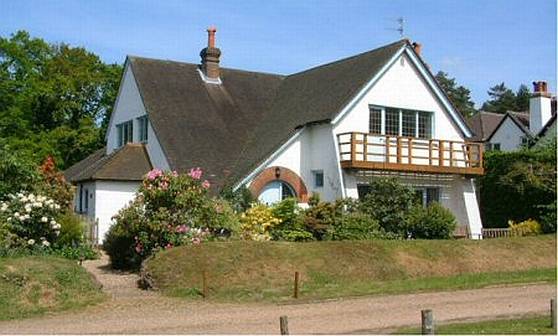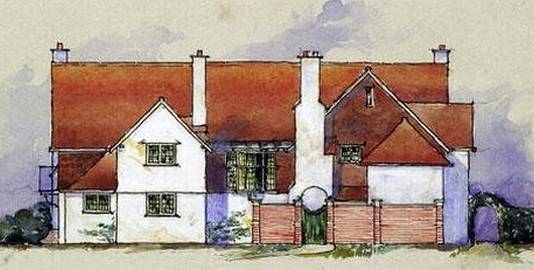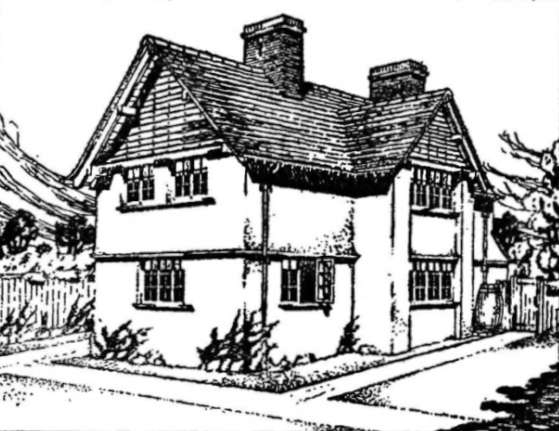Sarah Sullivan has kindly provided all the images here, except for that of Dickhurst; the photographs remain her copyright. She has also provided much of the material, which has then been written up and discussed by Jacqueline Banerjee. All other sources are given at the end. [Click on thumbnails for larger images. You may use these and the following images without prior permission for any scholarly or educational purpose as long as you credit the source and link your document to this URL in a web document or cite it in a print one.]

Blatchfeld (1888), adapted from two existing wayside cottages by Charles Harrison Townsend (1851-1928) in the village of Blackheath, Surrey. Source: Modern Bauformen Für Architektur Jahrgang V, Heft 11 (Modern Designs for Architecture Monthly, Vol. 5, Book 11). Click on image to enlarge it.
This house would be leased to the young Virginia Woolf in the very early twentieth century. She refers to it in a letter to Violet Dickinson in April 1903 as "three old cottages run together, and comfortable, which is the main thing" — no doubt describing it thus because the two distinct ends are linked by a central connecting section. Woolf was just one of the many writers and artists who have stayed or lived in the beautiful Surrey Hills, a part of the county now officially designated "An Area of Outstanding Natural Beauty." In fact, in the same letter Woolf complains that the place is "overrun with Cockneys [i.e. Londoners] and Culture" ( 73).
Blatchfeld, and Blackheath Village


Left to right: (a) Sir Henry Prescott's friend, Sir (then Professor) William Austen-Roberts, for whom Townsend designed Blatchfeld; he is seen here in an Elliot & Fry photograph from the Graphic of 1899. (b) Blatchfeld (shown in "An Artistic Treatment of Cottages," by Horace Townsend, The Studio, Vol. 6, issue 31, October 1895, 32).
Made more accessible by the railway in the mid-Victorian period, the Surrey Hills offered a real chance of escape from London into a peaceful, sometimes rugged landscape. As the Edwardian geographer Emily Catherine Matthews wrote:
in their great elevation, their abruptness of form, and the deep ravines which furrow their sides, these Southern Highlands more nearly resemble true mountainous country than anything else in this part of England. They stand, an isolated tableland, with a steep escarpment both to north and south, rising into wild hills and high, treeless, heather-clad commons. (2-3)
Townsend's first work in Blackheath had been Brantyngeshay, a house adaptation for Henry Warner Prescott (1837-1926), a member of a great banking family. Blatchfeld was designed for Prescott's friend, Sir William Chandler Roberts-Austen (1843-1902), a very eminent and influential metallurgist who was also a close friend of John Ruskin — by whom he had been much influenced (see Watson). On land which Townsend's brother Horace likened to the Yorkshire Moors, the architect was able to produce for his new client a long, picturesque, commodious house which Sir William named after the old Domesday Book name for the village. It was both impressive and, as Virginia Woolf discovered later, comfortable to live in.
Designed in the very year that Townsend became a Fellow of the Royal Institute of British Architects, Blatchfeld has several of the distinctive features of his later style: a long low arch in the centre of the front elevation, not over a doorway but over a bench, rooting the house in the land itself; small "eyebrows" in the roof, similar to those used by H. H. Richardson; and tall vertical lines, provided here not by towers but by chimneystacks, raising the house upwards. There is the same sense of organic growth inside, with easy access to the reception rooms; the utility rooms placed on the far right; and, rather than one grand staircase, the two stairways on either side that bear witness to Blatchfeld's origin as separate cottages. On the first floor, in the roof of the central part, is a long corridor with the tops of the staircases at either end. Despite not quite understanding the structure of the house, Woolf recognised its superiority to the other houses dotted around in the hills, with their red brick and "sham Elizabethan black and white" — "this house is better than that," she wrote approvingly (73).



Left to right: (a) The village well (1889), lovingly restored in 2010. (b) Rosemary Hill (1898), built for a Mrs Dykes (c) Chapel End (originally a Congregational chapel, drawn 1893, built 1901-02). The tower-like extension is much more recent.



Left to right: (a) Theobalds (1896). (b) Cobbins (1897), the house that Townsend designed for himself. (c) Dickhurst (1901-02), from Academy Architecture and Architectural Review, Vol. 21 (1902), p. 122.
.


Left to right: (a) Entrance to Cheshunt (1902-07), with Townsend's typical broad archway. The house has now been split and this doorway belongs to East Cheshunt. (b) Chimney-stack of Cheshunt, another a typical Townsend feature. (c) The Old Vicarage (1907), paid for by Mr Prescott.
These first adaptations were clearly successful. Soon after Blatchfeld was finished, Sir William commissioned Townsend to design a cover for the village well. St Martin's Church (1892-95) and a village hall (1896-97) followed. Prescott, a major benefactor of the village, met the cost of the hall. At the western end of the village, overlooking beautiful heathland and backing onto woods, it is rightly described on the village's own website as "a building of great character both externally and internally." By this time Townsend had also produced plans for a Congregational Chapel (designed 1893, built 1901-02, and now a private home), and Prescott had bought up other small parcels of land and asked him to design more country retreats for them. Townsend was to be responsible for at least sixteen structures here in all, including the vicarage shown above.
Amenities were brought up, too. Lady Roberts-Austen was an active woman who was involved with the Women's Building in Chicago at the 1893 World Expo, and who in 1899 became the first female chairman of a parish council. She campaigned long and hard for the village to be connected to the mains water supply, and was eventually successful. In this way, Blackheath grew and prospered, becoming "a very trim, largely Victorian hamlet" (Nairn et al. 112) in the Surrey Hills. Townsend liked it so much that he designed one of the houses for his own use, spending summers at Cobbins (1897) with his sister Pauline. Cobbins overlooks that other prerequisite of an English country village, the cricket ground, first cleared of heather in 1878 and levelled to form a cricket pitch in 1896.
Blackheath and the Garden Suburb Movement


The Glade, Letchworth, 1906. Left: front elevation. Right: side elevation (both from The Studio, Vol. 38 (1904), pp.130-31).
However well-thought-out and admired individually, the Blackheath buildings have not been considered particularly important. Adrian Forty, for example, writes dismissively that "until 1892 Townsend's practice was made up of minor domestic and ecclesiastical work" and that after 1901, "his practice was limited to relatively uninteresting private houses in southern England." Such an attitude may arise from Blackheath's location. In the early twentieth century the wilderness, no longer quite so wild, seemed to lose some of its appeal. For writers in particular the "colonisation of the Surrey hilltops was no more than a brief episode" (Trotter 26). Then, of course, Blackheath started to seem more remote again. Yet a few architectural historians do note Townsend's achievement here. His "highly individual church" is shown in Gillian Darley's Villages of Vision (124), and the village is listed in her Gazetteer (144) as one of the "post 17th-century planned villages in England and Wales"; and Alastair Service writes: "Townsend built many new houses, as well as the church and the chapel, in this attractive new village" (166). The last words here are significant, because Blackheath was, by the time Townsend finished his work there, very much a "new village."

The house Townsend designed in Temple Fortune Lane, Hampstead Garden Suburb, as shown in this sketch from Unwin and Scott, 79, has "weather-boarded gables and strong corner buttresses to the front gable," and "is a detached house of considerable interest" (from "Hampstead Garden Suburb").
Like several other housing developments, notably (in London) the 1830s Park Villages in Camden, and Norman Shaw's Bedford Park (1875-81) in Turnham Green, Blackheath Village in Surrey can be seen as a forerunner of the Garden City Movement. Indeed, the links are much clearer and closer here. Writing in The Studio in 1895, Horace Townsend had recommended adapting cottages in order to have "your own little stake in the country" (33) but the idea of large-scale settlement with a rural flavour really took shape with Ebenezer Howard (1850-1928), a Parliamentary reporter who had spent several years in the United States as a young man, and witnessed the rebuilding of Chicago and the layout of its suburbs after the disastrous fire of 1871 (see Ward 3) . His Garden Cities of Tomorrow appeared in 1898, when Blackheath was still expanding. Townsend quickly became associated with the movement, designing houses for both Hampstead Garden Suburb and Letchworth, prime examples of early twentieth-century garden cities. At Hampstead, his name appears among the "'Who's Who' of Edwardian domestic architecture" assembled by the Garden Suburb Development Company (Miller 104), and he designed The Glade at Letchworth for Sir John Gorst, a friend of Henrietta Barnett, with whom his sister Pauline was closely associated.
An overall plan for Blackheath has yet to be found; but even if such a plan never comes to light, the village has strong claims to be seen as much more than a handful of separate "minor domestic" works. Townsend's achievement here has been unfairly overshadowed by his more famous public buildings, and needs to be more fully appreciated.
Related Material
- St Martin's Church, Blackheath
- Park Villages East and West, Camden
- Holly Village, Highgate
- Norham Gardens in North Oxford
- Houses from a similar period in Providence, Rhode Island (USA)
Bibliography
Blackheath Village Hall. Web 16 March 2011. Updated 14 April 2025.
Darley, Gillian. Villages of Vision: A Study of Strange Utopias. London: The Architectural Press, 1975.
Forty, Adrian, rev. "Townsend, Charles Harrison (1851-1928)." The Oxford Dictionary of National Biography. Online ed. Web 16 March 2011.
"Hampstead Garden Suburb: Temple Fortune Lane, Willifield Way — Area 3, Character Appraisal." Web 14 March 2011.
Matthews, Emily Catherine. The Highlands of South-West Surrey: A Geographical Study in Sand and Clay. London: A & C. Black, 1911.
Miller, Mervyn. Hampstead Garden Suburb: Arts and Crafts Utopia?. Andover, Hamps.:Phillimore, 2006.
Nairn, Ian and Nikolaus Pevsner, rev. Bridget Cherry. The Buildings of England: Surrey. 2nd ed. London: Penguin, 1971.
Service, Alastair. Edwardian Architecture and its Origins. Oxford: Architectural Press, 1975.
Townsend, Horace. "An Artistic Treatment of Cottages." The Studio. Issue 31 (October 1895): 29-34. Web 16 March 2011
Trotter, W. R. The Hilltop Writers: A Victorian Colony among the Surrey Hills. Illustrated ed. Headley Down, Hampshire: John Owen Smith, 2003.
Unwin, Raymond and M. H. Baillie Scott, contributors. Town Planning & Modern Architecture at the Hampstead Garden Suburb. London: T. Fisher Unwin, 1909.
Ward, Stephen Victor. The Garden City: Past, Present, and Future. Abingdon, Oxon.: Taylor & Francis, 1992.
Watson, K. D., rev. "Austen, Sir William Chandler Roberts- (1843-1902)." The Oxford Dictionary of National Biography. Online ed. Web 16 March. 2011.
Woolf, Virginia. Letters, Vol. I: 1888-1912. The Flight of the Mind. Ed. Nigel Nicolson and Joanne Trautmann Banks. New York: Harcourt, 1975.
Last modified 14 April 2025